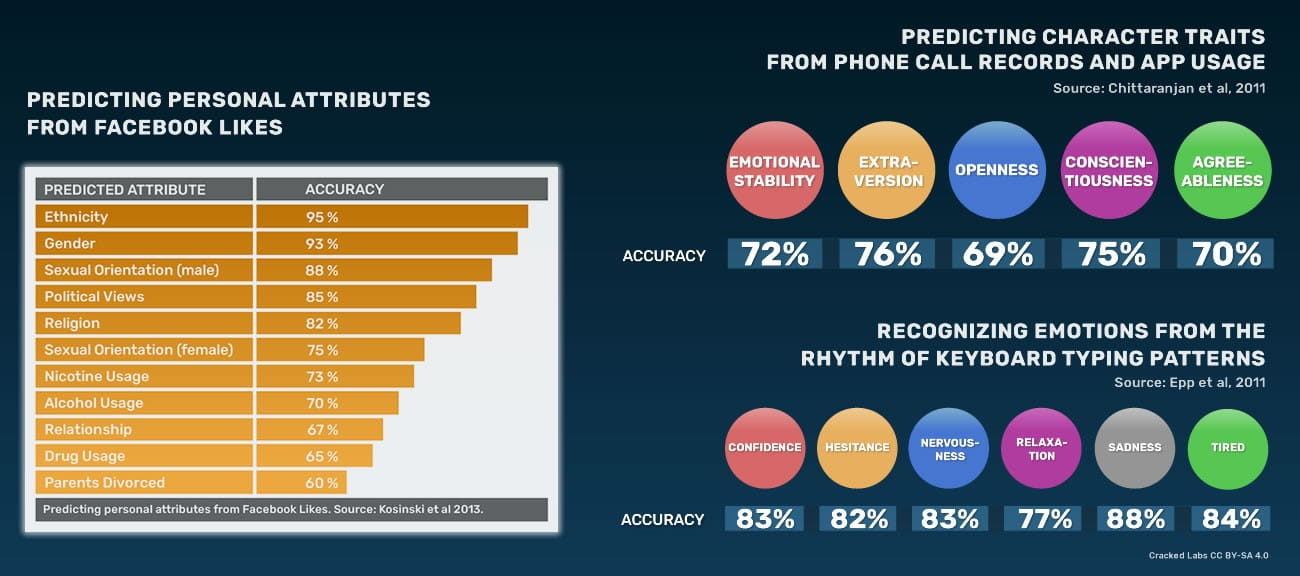
July 24, 2017 | InBrief
The implications of big-data marketing: Trends, solutions & use cases
The implications of big-data marketing: Trends, solutions & use cases
Across all industries – from utilities to banking and from healthcare to education – organizations are tapping into unprecedented amounts and types of actionable “big data” to understand consumers and drive powerful engagement. This is possible through evolving tools that analyze and parse data into hyper-personalized micro-segments of consumers – enabling an organization to deliver the right message to the right person at the right time and place. As you move into this world of big data-driven marketing, though, it is critical to understand exactly what big data marketing is and to exercise caution in how you use it. While knowing “everything” about customers may sound like a good idea, it can also make it easier to cross an ethical line.
It should come as no surprise that a person’s Facebook activity – likes, posts, shares, photos, app usage – can reveal a great deal about that individual. One can glean such personal characteristics as ethnicity, religious and political views, relationship status, and others. What may surprise you, though, is that Facebook also captures other information such as emotions recognized from the rhythm of keyboard typing patterns. And Facebook also is a significant buyer of third-party data – data that comes from a wide array of other industries, such as purchase and shopping data from retailers, audience data from media companies and digital publishers, and online activity and behavior from telecom and broadband providers. Facebook combines all of this data to identify more than 52,000 personal attributes – such as emotional stability, agreeability, life satisfaction, and more – that it uses to sort and categorize users and then sell hyper-personalized advertising capabilities to marketers.
Analyzing Facebook likes, phone data, and typing patterns
Just a few decades ago, this would have been inconceivable. Consumer segmentation was largely limited to characteristics such as age group, relationship category, and gender – categories so broad and vague as to be relatively meaningless. Today, marketers tap into “big data” and benefit from myriad identifiers and ways of combining them, allowing them to home into micro-segments that are eminently valuable.
While the term “big data” reflects its vast utility, in one very important way big data is really all about understanding the individual. In simple terms, detailed analysis of large amounts of structured and unstructured information about, say, the behavior of past customers enables an organization to predict the behavior of one.
This has tremendous use-case potential for marketers. But before you can begin to think about the possibilities, it is important to understand the tools and services driving this capability – because along with the opportunity to use big data comes the requirement to use it responsibly.
How this has become possible
Three technologies make possible the use of big data to identify these micro-segments:
- Customer relationship management systems (CRMs), which have been around since the introduction of database marketing in the 1980s. Today’s companies seek to collect as much customer data as possible. CRMs enable businesses to track and measure each and every interaction, whether in person or online. Typically, though, CRM data provides only a partial profile of an individual – transactional data or website visits, for instance.
- Data management platforms (DMPs), a much newer technology that allows users to link their first-party CRM data with third-party vendors that provide additional customer information. To develop a more holistic and useful picture of their customers, companies will upload CRM data to a data cloud, where identifiers are linked to third-party data to enrich their customer profiles, creating a 360-degree view of customers that serves as the basis for hyper-personalization.
According to a study by Cracked Labs, “Today’s consumer data management platforms allow for the definition of complex sets of rules that dictate how to automatically react to a specific criteria such as certain activities, people, or some combination thereof.” A DMP can be used to locate and identify people across devices, serve precise personalized marketing and advertising, and then measure the response. Companies providing DMPs include Oracle, Adobe, Salesforce (Krux), Wunderman (KBM Group.Zipline), Neustar, Lotame, and Cxense. - Predictive marketing platforms (PMPs), which, through machine learning-based scoring, make possible the use of CRM/DMP data to identify the right message for the right person at the right time and place. Predictive marketing software enables one to forecast outcomes and trends through algorithms that parse through historical customer data, identifying ideal customers and uncovering “lookalikes.” It represents once of the more consequential advances for marketing in recent memory, doing for the art and science of the industry what Watson and Crick’s double helix did for the study of DNA. Companies in the predictive analytics sphere include 6sense, GrowthIntel, Lattice Engines, and Radius.
Ubiquitous data collection – and how we got here
The business of collecting and selling data about individuals is not new. Data brokers have a long history of collecting such information. But sources for such data were once limited to newspaper and magazine subscriptions, book club memberships, catalog purchases, seminar and conference attendance, and warranty registration forms – in other words, where someone had to fill out a form to provide the data. With the institution of loyalty reward programs, the collection of purchase/transaction data took off. And the evolution of the Internet has taken the collection of personal data to ever-new heights.
Online tracking companies at first used cookies to discern online behavior, but cookies don’t work with most mobile devices, which are increasingly how users exist online. And because users can delete cookies or disallow them outright, these companies turned to sophisticated algorithms that assemble distinct “digital fingerprints.” Digital fingerprinting allows a provider to assess aspects of the device being used to deliver content, such as installed plugins and extensions, the size of the screen, the time zone, fonts, and others. Taken together, these bits of information help data collectors identify specific individuals and do so from device to device.
Such online data collection is ubiquitous. Facebook, along with many other large tech brands such as Google, LinkedIn, and Apple collect data about billions of individuals (Facebook is a unique case in that it is not only a provider of data through the advertising it sells; it is also a significant buyer of third-party data). In one study, Princeton researchers analyzed one million distinct websites and found that upwards of 80,000 third parties receive data about those websites’ visitors. And a further cross-sectional study of mobile apps found that 85 to 95 percent of free apps and some 60 percent of paid apps share data with third parties. Most users do not really understand the amount of data that is being delivered to large-scale data collectors.
Today’s data product – detailed digital dossiers
The information gathered about individuals is largely the purview of data brokers, and these data brokers use that information to compile detailed dossiers on individuals that include information about occupation, education, ethnicity, religion, children, political views, hobbies, and recreational activities, as well as financial data such as income, property and vehicle ownership, and credit card usage. With the ability to track online and mobile activity, the dossier will typically include the websites they visit, the movies and videos they stream, the apps they use, and the geographic locations they visit. What’s more, in many cases these profiles also include prediction scores about future activity such as changing jobs, having children, being treated for severe illness or depression, buying a home or car…ad infinitum.
Should and how will you use this data?
The scope of data available to marketers is somewhat mind-boggling. So much so that many marketers don’t take advantage of it because they don’t know what is available or how to make use of it. Indeed, the use of big data requires many conversations within your organization to develop a strategy for what data will be useful and for how to use the data, as well as the metrics that will define success. Failure to develop a strategy before diving into big data will only result in a lot of wasted time and money.
Beyond the value of such data to your strategy, there is another important consideration. All of this raises concerns about how consumers interact with us, how we collect and use data, and whether the use of some of this data has ethical implications. Inappropriate use of data can and will alienate customers if it is intrusive and doesn’t connect.
Organizations and marketers must consider the ethical implications and responsibilities of utilizing some of this information and the reaction that may come from customers who were unaware this data has been shared. We have all heard the story of the 15-year-old pregnant girl who was outed to her father when Target sent coupons for baby supplies to her house. It turned into a public relations nightmare for the company and led Target to institute safeguards that would prevent something like that from happening again.
The best way to prevent such a catastrophe is to determine what types of information align clearly with your company’s culture, values, and mission. Only then should you look for and access third-party data that will help you drive powerful customer engagement and achieve other success metrics.
If you do dive in, be a responsible data guardian
There are many types of data out there from a multitude of sources, and you may be tempted to get as much as you can. After all, it would make sense to think that the more you know about your customers and potential customers, the better off you will be. But first ask yourself these questions: Do you know all of “what’s known” about you, and would you want others to have that information? Do you know what data from all that is “out there” is right for your business? And is accessing that data about customers in their best interest?
We must recognize that privacy is about the right to be human. Most people will be naturally suspicious as to how, for example, you know they have had a death in the family because one of them searched for nearby funeral homes. If you acquire and use data from these sources, be responsible and act ethically.

